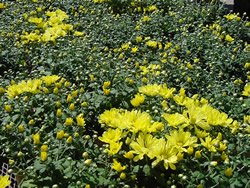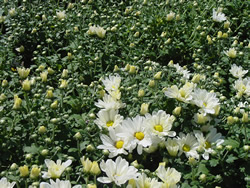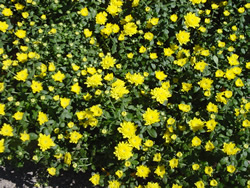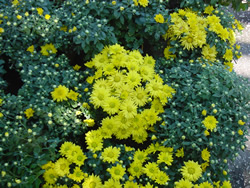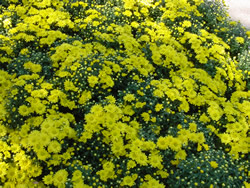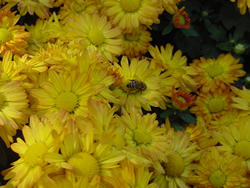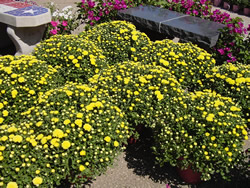INSTANT COLOR
AND INSTANT WILDLIFE ATTRACTION WITH GARDEN MUMS AND OTHERS
Garden mums or chrysanthemums don't bloom
until fall because they're light sensitive-when days get
shorter and nights longer in September, the vegetation
stops growing and they begin flowering. However, if you
wait until fall to plant, plants will bloom when too small.as
described in a Parsons-when-he-had-hair video at:
http://floriculture.tamu.edu:7998/movies/FMPro?-db=videoarchive.fp5&-format=detail2.html&-lay=layout%20%231&topic=ornamentals&-max=8&-recid=32831&-find=
The best way to have a beautiful chrysanthemum
display is to buy them already "finished" at
local nurseries. The plants are dirt-cheap so you will
be able to buy many picture-perfect plants of any color
you want. For instance, one of my favorite nurseries is
selling them for $2 per six inch pot or 10 for $19. So
for a $20 bill, you can have a professional planting of
these flowers which are available in a variety of shapes,
sizes and colors that make a dazzling display. Then simply
"plant" or sink the plants still in the pots
into your planting bed and you have a spectacular bloom
display in a matter of minutes. If you want immediate
color, choose the plants with blooms fully open. If you
want the color spike to be in a week or so, choose plants
with buds just beginning to swell into full bloom. When
you water use a water wand so you won't damage the flowers.
Be sure to water each pot below the flower canopy. The
pots will not dry as fast when they are surrounded by
the planting bed soil and mulch.
Nothing lasts forever so after about two weeks of beautiful
bloom (depending on heat and growing conditions), the
blooms will fade. What should you do? If your reputation
as the best mum grower in the state is to continue, I
recommend you replace these specimens with budding-and-soon-to-be-in-full-bloom
plants. This process should continue well pass Thanksgiving.
The major dilemma occurs about what to do
with the out-of-bloom mums. The best answer is to use
them and lose them-throw them away as described in the
video at: http://floriculture.tamu.edu:7998/movies/FMPro?-db=videoarchive.fp5&-format=detail2.html&-lay=layout%20%231&topic=ornamentals&largeQT=mums&-recid=32861&-findall=
But that sort of talk is blasphemous to the Plant's Rights
folks and sentimental plant people-not to mention the
frugal gardeners. So for those folks, here is what to
do. Remove the root system of the plants from the pot
and plant in a permanent bed which receives full sun.
Before planting add 3 pounds of a slow-release 19-5-9
fertilizer per 100 square feet of planting bed. Set plants
at same depth they were grown in the nursery and water
thoroughly. The plants will normally not bloom again until
next fall.
In the spring you will begin to groom and
care for the plants through the summer in order to obtain
a stronger plant and, consequently more flowers in the
fall. The general range of garden pests, such as aphids,
thrips, mites and leaf miners, will bother mums. The same
pesticides that work on roses and other spring flowers
will also do the job for your mums.
To develop strong branches and good flowering
plans, pinch off about one inch of the stem tip two or
three times during the growing season. Don't pinch after
July 15. Start pinching when stems are six to eight inches
long and repeat when the new shoots growing from the leaf
axils reach four to six inches in length. This will prevent
those tall, leggy plants that break over when the flowers
start to show color.
Fertilize every three to four weeks with
a slow-release fertilizer at the rate of one pound per
100 square feet of planting bed and provide supplemental
irrigation during drought periods. If mum plants suffer
from lack of moisture, the stems become hard and woody
and new growth virtually stops so maintain a thick layer
of mulch around the plants at all times. Chrysanthemums
seem to be very appreciative of any extra care and attention
you give them and will reward you with extra blooms and
a longer flowering period.
Chrysanthemums are not the only plants which
can be slam-dunked into the landscape to beautify the
fall gardens. You should think about doing the same with
plants which attract and feed migrating butterflies and
hummingbirds. Some of the plants which are listed at:
http://www.plantanswers.com/hummingbird_plants.htm
include summer favorites which can now be found in full
bloom in nurseries such as: Autumn Sage, Cherry Sage (Salvia
greggii), Chaste Tree (Vitex agnus-castus), Firebush (Hamelia
patens), Firecracker Plant (Russelia equisetiformis),
Firespike (Odontonema strictum), Lantana (Lantana spp.),
Mexican Cigar (Cuphea ignea), Mexican Bush Sage (Salvia
leucantha), Milkweed, Butterfly Weed (Asclepias tuberosa),
Milkweed, Mexican Oleander (Asclepias curassavica), Pentas
(Pentas spp.), Petunia (Petunia species), Pride of Barbados
(Caesalpinia pulcherrima), Red Salvia (Salvia splendens),
Red Yucca (Hesperaloe parviflora), Scarlet Sage (Salvia
coccinea), Shrimp Plant (Justicia brandegeana), Turk's
Cap (Malvaviscus spp.), Verbena (Verbena X Hybrida 'Blue
Princess'), and Yellow Bells or Esperanza (Tecoma stans).
You don't have to keep refilling the hummingbird and butterfly
feeder----just put Nature's best feeders in your own back
yard.
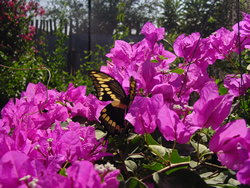 This
is the month when butterflies and hummingbirds begin their
migrations through this area. In celebration of the Monarch
butterflies' journey through the Texas Hill Country en
route to Mexico, Wildseed Farms of Fredericksburg, Texas
is hosting the 2nd annual Monarch Celebration on October
8th and 9th, 2005. Each fall, millions of Monarch butterflies
make the long, perilous journey from the southern borders
of Canada to their over-wintering grounds in the mountains
of Mexico and along the pacific coast states.
This
is the month when butterflies and hummingbirds begin their
migrations through this area. In celebration of the Monarch
butterflies' journey through the Texas Hill Country en
route to Mexico, Wildseed Farms of Fredericksburg, Texas
is hosting the 2nd annual Monarch Celebration on October
8th and 9th, 2005. Each fall, millions of Monarch butterflies
make the long, perilous journey from the southern borders
of Canada to their over-wintering grounds in the mountains
of Mexico and along the pacific coast states.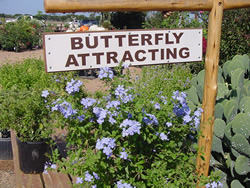 In combined effort with Monarch Watch at the University
of Kansas, Monarchs will be "tagged" and released
throughout the United States as part of a large-scale
mark and recapture program to aid in the study and research
of their migration. Tagging consist of placing a tiny
official Monarch Watch self-adhesive tag on the butterfly's
wings. Wildseed Farms' Monarch Celebration tagging and
release event will be held on Saturday, October 8th at
l1:30 a.m. and 3:30 p.m., and again on Sunday, October
9th at 11:30 a.m. and 3:30 p.m. Visitors can observe Monarch
tagging and release demonstrations and see graceful
In combined effort with Monarch Watch at the University
of Kansas, Monarchs will be "tagged" and released
throughout the United States as part of a large-scale
mark and recapture program to aid in the study and research
of their migration. Tagging consist of placing a tiny
official Monarch Watch self-adhesive tag on the butterfly's
wings. Wildseed Farms' Monarch Celebration tagging and
release event will be held on Saturday, October 8th at
l1:30 a.m. and 3:30 p.m., and again on Sunday, October
9th at 11:30 a.m. and 3:30 p.m. Visitors can observe Monarch
tagging and release demonstrations and see graceful 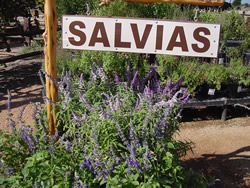 butterflies
surrounded by the plants they use for nectar and as host
plants. Witness the magic of the butterfly life cycle
and learn the basics of butterfly gardening.
butterflies
surrounded by the plants they use for nectar and as host
plants. Witness the magic of the butterfly life cycle
and learn the basics of butterfly gardening.
"Our mission at Monarch Celebration is to educate
the public on the Monarch butterfly's migration and generate
interest in the tagging program" John R. Thomas said.
"I believe knowledge and understanding are the first
steps to respect and appreciation of nature."
There is no charge to Wildseed Farms' Monarch Celebration,
which includes tagging demonstrations. The standard admission
fee (see butterfly haus website) is charged for entrance
to the Meadows, which includes the live butterfly exhibit.
The Butterfly Haus is open April through October, weather
permitting. For additional information on the Butterfly
Haus, see: http://www.wildseedfarms.com/butterfly_haus.htm
or call them locally at (830) 990-8080, or toll- free
at (800) 848-0078.
The Wildseed Farms Butterfly Haus is now
the only butterfly within 200 miles since a horrible thing
happened to the original butterfly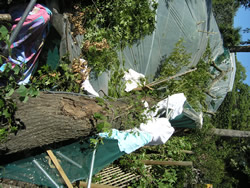 house at the San Antonio Zoo. During the night of September
23, 2005, a 45-foot red oak tree fell onto and destroyed
the San Antonio Zoo's butterfly exhibit. Butterflies!
Caterpillar Flight School opened three years ago and was
a huge tented structure which housed 350 or more South
and Central American butterflies. "We prepared for
possible storm damage from Rita, but as of yesterday,
the storm's course was not going to effect San Antonio.
There were no reports of heavy winds at the Zoo. At this
time is seems to be an issue of a very old hollowed out
tree. Unfortunately it destroyed one of our most popular
exhibits. However, we are grateful that it happened during
the night when there are no visitors in the exhibit,"
said Steve McCusker, Zoo Director. The following morning
Zoo staff netted all but two dozen butterflies from the
torn enclosure. "By the end of the day, most of the
remaining butterflies were caught since they did not travel
far," said McCusker. The caught butterflies were
shipped to a Saint Louis butterfly conservatory. The Zoo
will evaluate and determine if it will rebuild the exhibit
that would cost approximately $30,000 to rebuild.
house at the San Antonio Zoo. During the night of September
23, 2005, a 45-foot red oak tree fell onto and destroyed
the San Antonio Zoo's butterfly exhibit. Butterflies!
Caterpillar Flight School opened three years ago and was
a huge tented structure which housed 350 or more South
and Central American butterflies. "We prepared for
possible storm damage from Rita, but as of yesterday,
the storm's course was not going to effect San Antonio.
There were no reports of heavy winds at the Zoo. At this
time is seems to be an issue of a very old hollowed out
tree. Unfortunately it destroyed one of our most popular
exhibits. However, we are grateful that it happened during
the night when there are no visitors in the exhibit,"
said Steve McCusker, Zoo Director. The following morning
Zoo staff netted all but two dozen butterflies from the
torn enclosure. "By the end of the day, most of the
remaining butterflies were caught since they did not travel
far," said McCusker. The caught butterflies were
shipped to a Saint Louis butterfly conservatory. The Zoo
will evaluate and determine if it will rebuild the exhibit
that would cost approximately $30,000 to rebuild.
The exhibit was a photographer's paradise
filled with beautiful wildlife gardens and magnificently
colored butterflies. The exhibit provided close-up views
of butterflies coming out of their chrysalis and preparing
their wings for flight. The Butterfly Exhibit was funded
by the generosity of Capital Group/American Funds, G.A.C.
Halff Foundation, Boeing Company and San Antonio Water
System
Luckily, the Wildseed butterfly exhibit
is fashioned after the one which was at the San Antonio
Zoo. The Wildseed Farm's exhibit is much larger and beautifully
landscaped with a waterfall and bridges. There is also
a hummingbird observation window so hummingbirds and butterflies
can be observed from the same structure. You can watch
the hummingbirds feed while you are being swarmed by hundreds
of butterflies.
Don't miss an opportunity to be a part of
this year's hummingbird and butterfly migration -IN YOUR
OWN BACKYARD!





